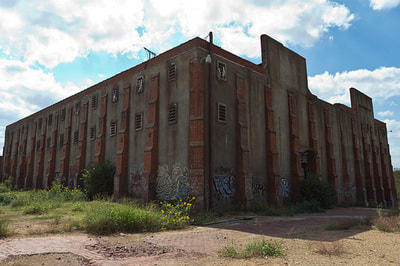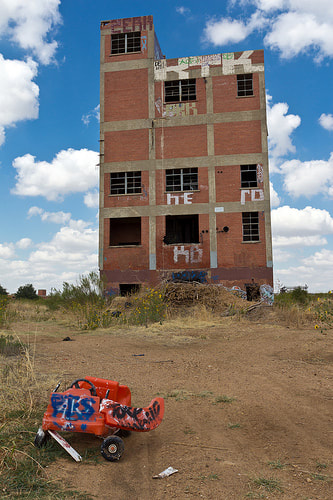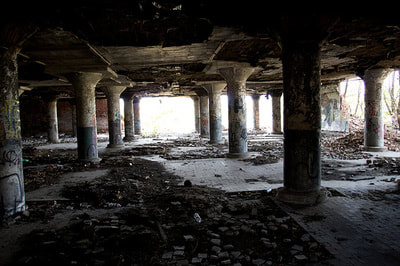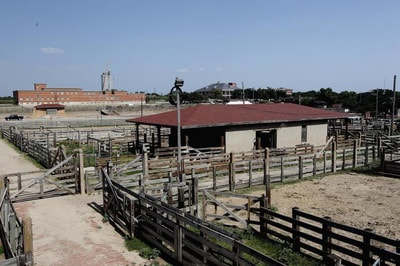Animal Hauntings
 In 1916, retired Scotland Yard Inspector Arthur Springer took this picture in Tingewick, Buckingham, England. At the moment he captured the photograph, there was reportedly no dog in the frame at all.
In 1916, retired Scotland Yard Inspector Arthur Springer took this picture in Tingewick, Buckingham, England. At the moment he captured the photograph, there was reportedly no dog in the frame at all.
In the field of paranormal investigations, it's not only humans but animals that linger on this earthly plane. Sometimes they are residual, and other times they are intelligent, restless and tied to a certain place. Descriptions are often those of animal that do not exist any longer, or where many animals were slaughtered.
The Horse Butchers
Homestead & Redland, Fla. (March 2016)
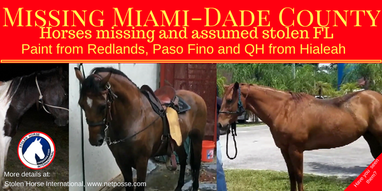 An example of two horses stolen from Hialeah, Florida c.2017
An example of two horses stolen from Hialeah, Florida c.2017
In 2016, reports came to Miami Ghost Chronicles, from different sources that were believed to be animal hauntings possibly tied to a spate of cases where horses were stolen and butchered for their meat. Reports ranged from neighing from areas where there were absolutely no animals, smells, and even one report of an actual sighting of the apparition of a horse. Most of these areas, after nightfall have no city lighting, and are dotted by small farms and agricultural fields.
In December 2015, Francisco Alvarado wrote an article (warning graphic images are part of the file) Illegal Horse Butchers Are Running Wild Across Florida describing these horrible events.
In December 2015, Francisco Alvarado wrote an article (warning graphic images are part of the file) Illegal Horse Butchers Are Running Wild Across Florida describing these horrible events.
Slaughter Houses
 Ft. Worth stockyards (Source - North Fort Worth Historical Society)
Ft. Worth stockyards (Source - North Fort Worth Historical Society)
- Between 1866 and 1890 more than 4 million heads of cattle came through Fort Worth as drovers headed up the Chisholm Trail. In 1876, with the arrival of the railroad the Union Stockyards were built to house cattle as they were loaded for transport, however by 1893 the owners realized there was more money to made by slaughtering the animals there. By 1900 Armour & Co and Swift & Co had built meat packing plants. The stockyard was later renamed to the Fort Worth Stockyards.
- Millions of animals were killed at this site. Their peak year was 1944, when over 5 million head of livestock were processed there. The fortunes of the stockyard declined after WWII with the advent of the trucking industry. They stayed in business though the 1980s when over 57,000 were sold in 1986. How many millions of animals were slaughtered there over the years?
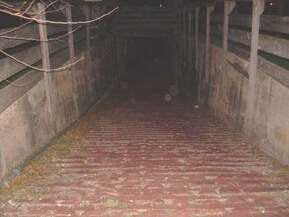 Orbs photographed at the animal loading ramp in the Fort Worth Stockyards (Courtesy Red River Historian)
Orbs photographed at the animal loading ramp in the Fort Worth Stockyards (Courtesy Red River Historian)
The stockyard stations which consisted of hog and sheep pens have been remodeled into restaurants and shops, however the slaughter houses remain as they were before including the ramps and halls.
Next to the Fort Worth Stockyards is a large abandoned industrial complex that used to be the Swift Meat Packing Plant. It was part of Gustavus Swift’s family of companies and was in operation from about 1902 to 1971. It soon fell into disrepair due to numerous fires from trespassing vagrants, gang activity and graffiti taggers.
Next to the Fort Worth Stockyards is a large abandoned industrial complex that used to be the Swift Meat Packing Plant. It was part of Gustavus Swift’s family of companies and was in operation from about 1902 to 1971. It soon fell into disrepair due to numerous fires from trespassing vagrants, gang activity and graffiti taggers.
July 2016, crews began to tear down buildings on the site as part of a $175 million redevelopment plan for the Stockyards. Only one building at the former meat packing plant will remain – the former laboratory.
(Photos courtesy of Rust2.com)
(Photos courtesy of Rust2.com)
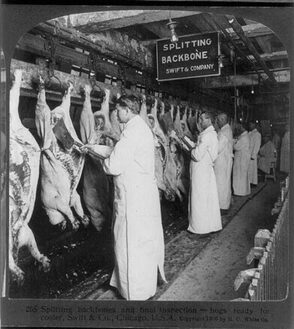 Swift Co. slaughterhouse Chicago c.1906
Swift Co. slaughterhouse Chicago c.1906
Structures and parks built on the site of slaughterhouses report feelings of panic, dizziness and not being alone. The Mellwood Arts Center in Kentucky was built on the site of the Fischer Meatpacking plant. The story is that Buddhist monks were brought in before the renovation to do a type of exorcism to rid the space of evil spirits and the horrific vibes invoked by the suffering of so many animals. They had to complete their rituals 4 times, and even then they were never fully satisfied that the cleansing had been complete.
Amy Fitzgerald, a criminology professor at the University of Windsor in Canada, has found statistics that prove a correlation between slaughterhouses and the commission of brutal crimes. She used FBI’s Uniform Crime Report issued between 1994 to 2002. She became interested in this research after finding that crime rates increased without explanation when factories were opened in a community.
Her findings indicated that when an average sized slaughterhouse with 175 employees started operating the number of arrests increased by 2.24 and reports by 4.69. The rate increased as the size of the business did, and she took into account new residents in the area, the average age of men living there, and the number of immigrants. When residents in the area complained about the increase in crime, the companies blamed it on immigrant populations nearby.
Professor Fitzgerald surmised that her findings coincided with what people had found since industrialized abattoirs started in the 19th century, which was that people exposed to the killing of a large number of animals on a continuous basis become disturbed and lose empathy.
Another explanation for this uptick in criminal activity is that slaughterhouses in order to fill their job openings, hire ex-convicts.
Amy Fitzgerald, a criminology professor at the University of Windsor in Canada, has found statistics that prove a correlation between slaughterhouses and the commission of brutal crimes. She used FBI’s Uniform Crime Report issued between 1994 to 2002. She became interested in this research after finding that crime rates increased without explanation when factories were opened in a community.
Her findings indicated that when an average sized slaughterhouse with 175 employees started operating the number of arrests increased by 2.24 and reports by 4.69. The rate increased as the size of the business did, and she took into account new residents in the area, the average age of men living there, and the number of immigrants. When residents in the area complained about the increase in crime, the companies blamed it on immigrant populations nearby.
Professor Fitzgerald surmised that her findings coincided with what people had found since industrialized abattoirs started in the 19th century, which was that people exposed to the killing of a large number of animals on a continuous basis become disturbed and lose empathy.
Another explanation for this uptick in criminal activity is that slaughterhouses in order to fill their job openings, hire ex-convicts.
 Abandoned Cape Fear Packing House c.2009
Abandoned Cape Fear Packing House c.2009
On the banks of Cape Fear in present day Navassa, NC, sometime in the late 1700s, Dr. Thomas Cobham a prominent physician from Wilmington acquired a piece of land and built Cobham Plantation, which was used to farm rice. Records of the time indicate that in 1821 approximately 29 slaves lived on the land, and that it was still a working farm into the 1860s. It is unknown how the Civil War affected Cobham Plantation, however in 1917, G. Herbert Smith built the Cape Fear Packing House on the site where the plantation once stood.
Due to its proximity to the Cape Fear River the meat-packing plant, which slaughtered cows and hogs became a meat supplier by both ship and train. Mr. Smith who is one of the purported ghosts at the site, was reported by the local newspapers of the time, as accidentally dying when he asphyxiated from a gas leak in his home in May 1921. Rumors swirled though that he had committed suicide by hanging in his home, but since he was a prominent citizen this fact was never published. An urban legend which fueled the property's reputation for being haunted, retold that he had committed suicide by hanging inside the plant itself. By 1922, the packing house was declaring bankruptcy, and even though it was bought by another meat packing company, it never took off, and there is not much information as to the use of the building or the land for many years.
Over the years, the building stood empty and fell into decay. It was found at the end of a dirt road and was frequented by teenagers who hung out there, partly attracted by its reputation for being haunted. Ironically in 1982, one of these teenagers, 16-year-old David L. Jones of Wilmington fell from the four-story building's top floor, plummeting to his death. That same year, at least one other person, a woman, was injured on the property. On October 29, 2008, The State Port Pilot of Southport reported on a psychic group that visited the site and reported paranormal activity there.
For the 90 years it stood, it is unknown if other deaths or violence were associated to this location as it is found in a desolate area. Even though it was used for only a few years as an abattoir, it is thought by many in the paranormal field that the slaughter of animals will open a portal to the other side. This is also the reason why many dark art rituals have blood sacrifices as part of their invocation of entities.
The post-apocalyptic NBC series Revolution used the plant for location shooting in September and October of 2012.
This building was demolished April 2014, to accommodate the extension of the I-140. The date and time of the demolition was purposely kept secret as to avoid having crowds show up.
Due to its proximity to the Cape Fear River the meat-packing plant, which slaughtered cows and hogs became a meat supplier by both ship and train. Mr. Smith who is one of the purported ghosts at the site, was reported by the local newspapers of the time, as accidentally dying when he asphyxiated from a gas leak in his home in May 1921. Rumors swirled though that he had committed suicide by hanging in his home, but since he was a prominent citizen this fact was never published. An urban legend which fueled the property's reputation for being haunted, retold that he had committed suicide by hanging inside the plant itself. By 1922, the packing house was declaring bankruptcy, and even though it was bought by another meat packing company, it never took off, and there is not much information as to the use of the building or the land for many years.
Over the years, the building stood empty and fell into decay. It was found at the end of a dirt road and was frequented by teenagers who hung out there, partly attracted by its reputation for being haunted. Ironically in 1982, one of these teenagers, 16-year-old David L. Jones of Wilmington fell from the four-story building's top floor, plummeting to his death. That same year, at least one other person, a woman, was injured on the property. On October 29, 2008, The State Port Pilot of Southport reported on a psychic group that visited the site and reported paranormal activity there.
For the 90 years it stood, it is unknown if other deaths or violence were associated to this location as it is found in a desolate area. Even though it was used for only a few years as an abattoir, it is thought by many in the paranormal field that the slaughter of animals will open a portal to the other side. This is also the reason why many dark art rituals have blood sacrifices as part of their invocation of entities.
The post-apocalyptic NBC series Revolution used the plant for location shooting in September and October of 2012.
This building was demolished April 2014, to accommodate the extension of the I-140. The date and time of the demolition was purposely kept secret as to avoid having crowds show up.

